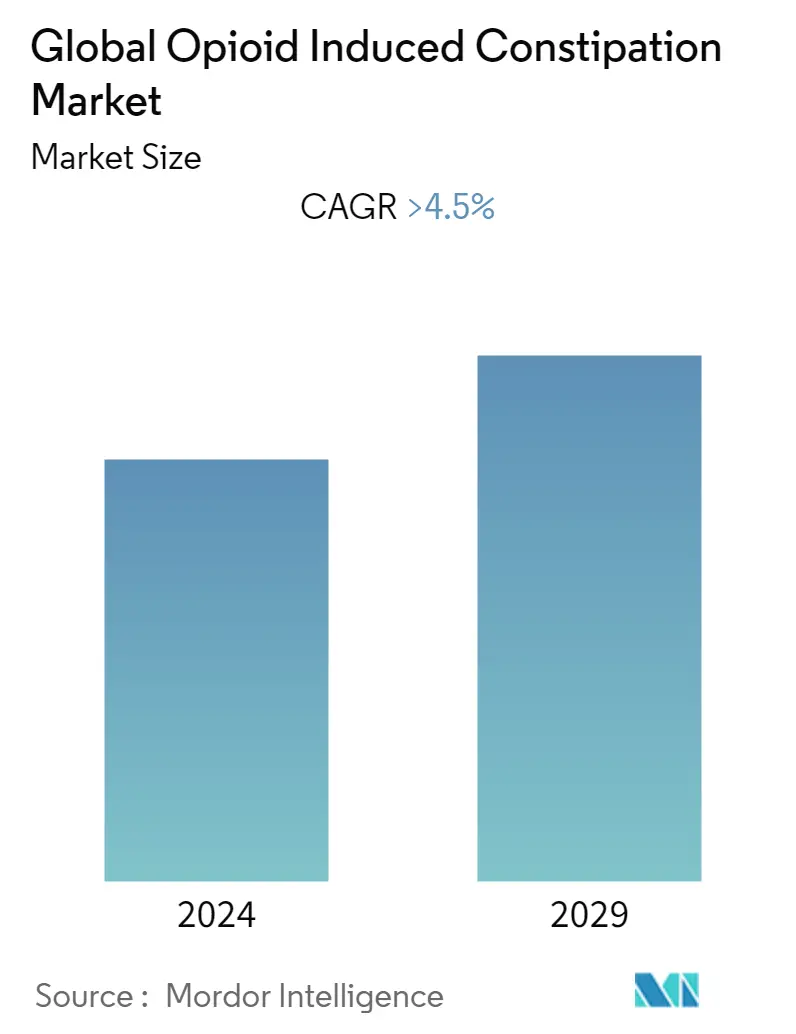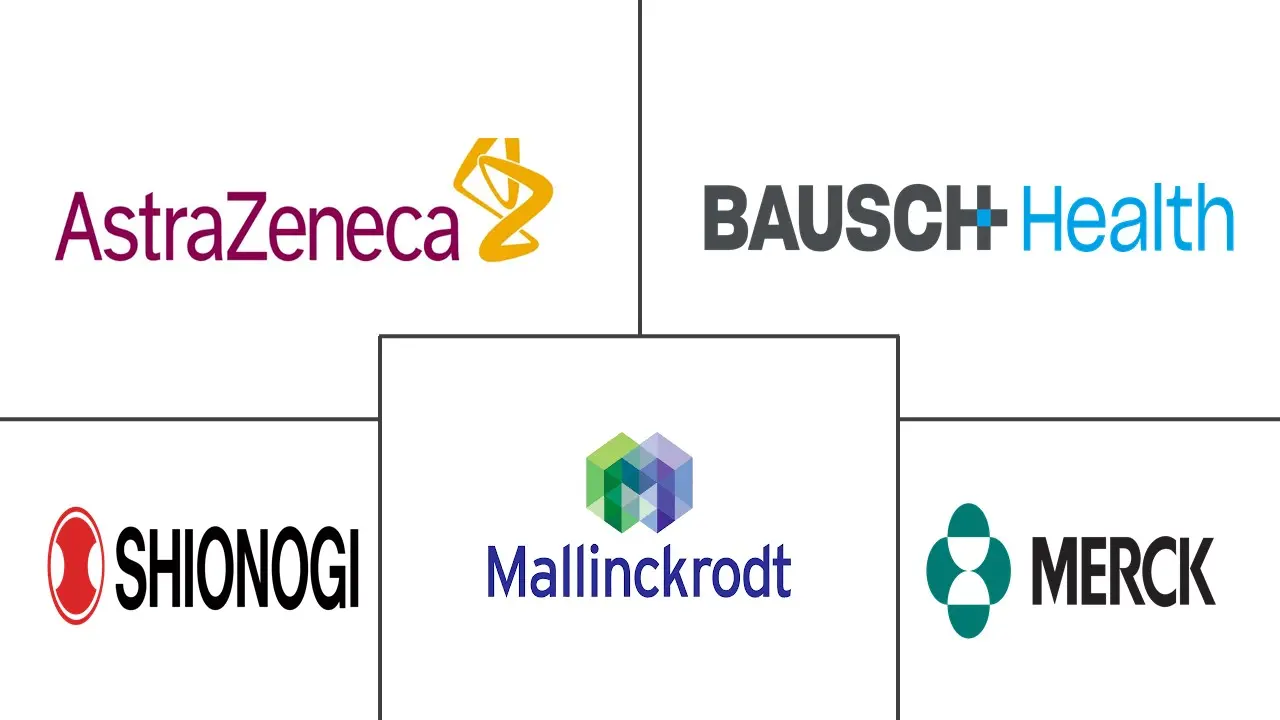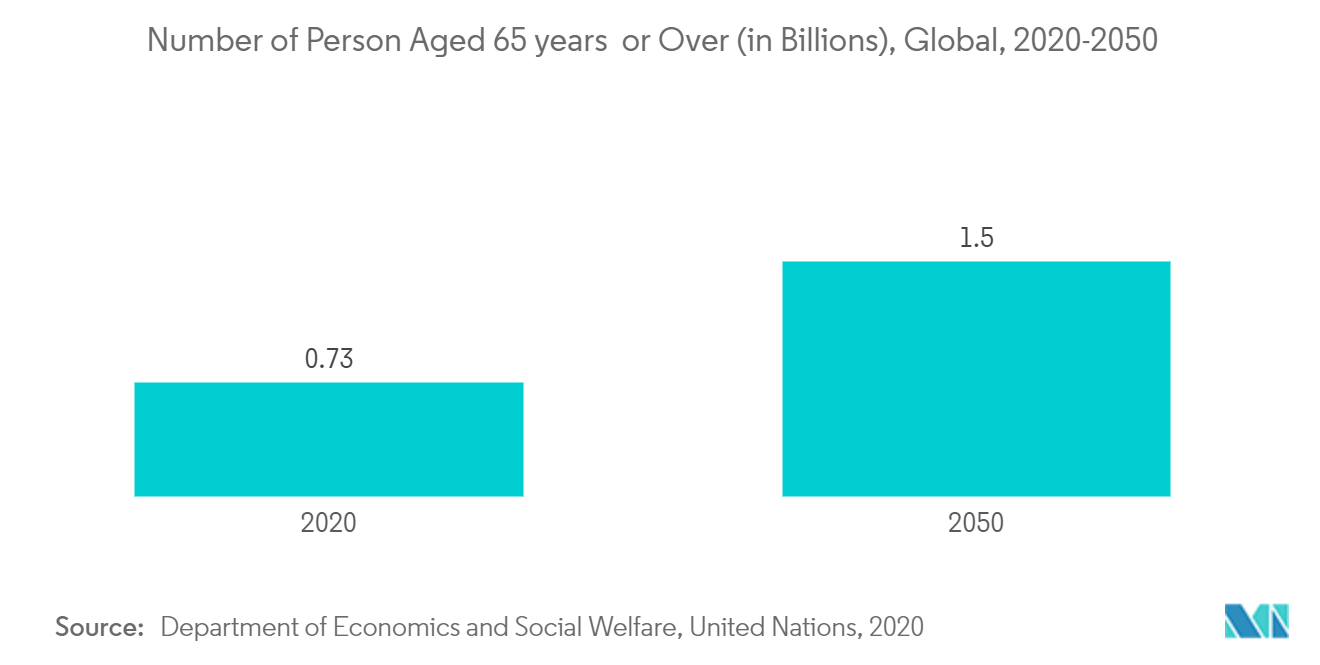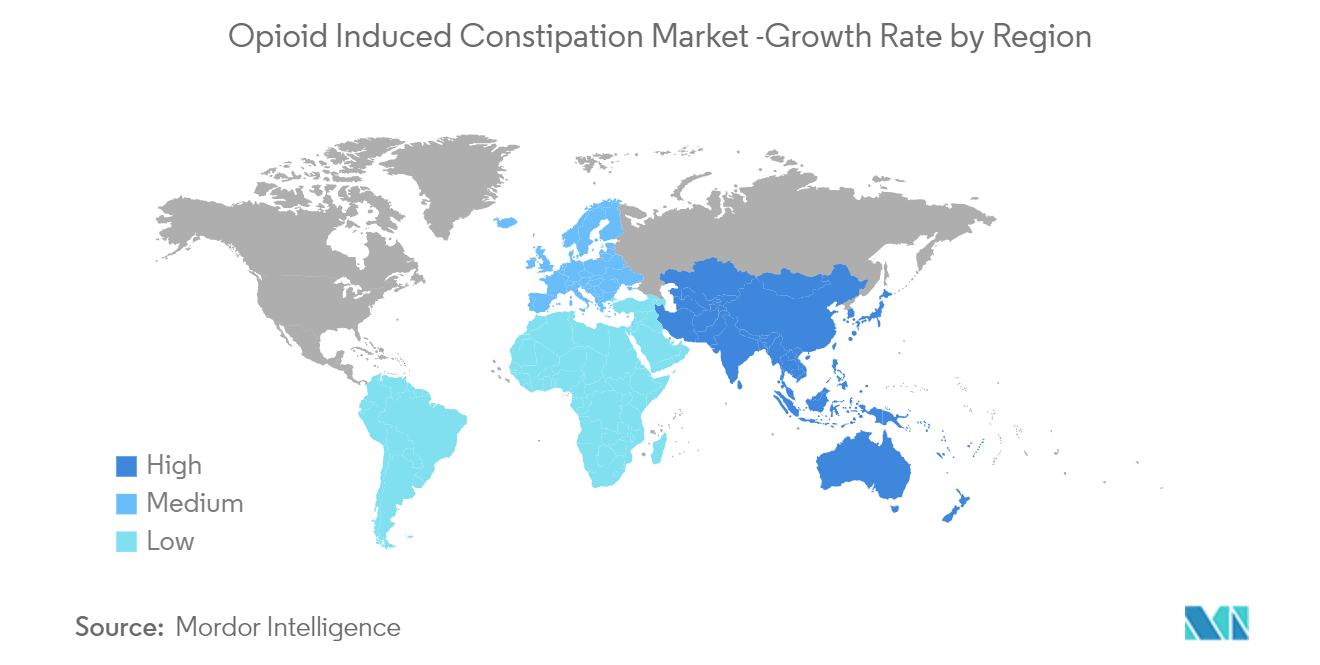Opioid Induced Constipation (OIC) Market Size

| Study Period | 2019 - 2029 |
| Base Year For Estimation | 2023 |
| Forecast Data Period | 2024 - 2029 |
| CAGR | 4.50 % |
| Fastest Growing Market | Asia Pacific |
| Largest Market | North America |
Major Players
*Disclaimer: Major Players sorted in no particular order |
Opioid Induced Constipation (OIC) Market Analysis
Opioid-Induced Constipation (OIC) market studied was anticipated to grow with a CAGR of nearly 4.5% during the forecast period, 2022-2027.
Opioid use at high doses and for long periods can impair immune system function, complicating the course of COVID-19 disease. In various stages of COVID-19, potential suppression of parts of the immune response may be important in prevention, clinical support, and therapeutic use of medications. Additionally, as per the World Health Organization update of August 2021, During the COVID-19 pandemic, there are a substantial increase in drug overdose deaths reported in the USA, primarily driven by rapid increases in overdose deaths involving synthetic opioids Because of such instances, the federal government has taken initiatives to careful usage of opioids drugs and side effects associated with it, which can later impact the growth of the studied market.
The major factor attributing to the growth of the market is an increasing number of geriatric patients as these patients use opioid analgesics such as morphine, hydromorphone, codeine, etc. as a prescription for chronic non-cancer pain which has severe adverse effects on the digestive system resulting in huge demand for OIC drugs. For instance, according to the Center for Diseases Control and Prevention November 2021, the number of OIC prescriptions increased by 153,260,450 in 2019 and 142,816,781 in 2020. Thus, the rising volume of patient pool with opioid users demands efficient medication for OIC ailments which is likely to fuel the Opioid-Induced Constipation market over the forecast period.
The geriatric population is expected to have a significant impact on the market studied as people aged above 65 are more prone to chronic diseases. According to the World Health Organization Facts 2021, by 2030, 1 out of every 6 people on the planet will be 60 years old or older. The number of people aged 60 and up is expected to rise from 1 billion in 2020 to 1.4 billion by 2050. By 2050, the global population of people aged 60 and above will get double to reach 2.1 billion. Between 2020 and 2050, the number of people aged 80 and above is expected to triple, reaching 426 million. Thus, the increasing use of opioid analgesic prescriptions along with the growing geriatric population in developed nations boosted the market over the forecast period.
However, lack of awareness about OIC among the patients considering it as a syndrome resulting in a preference for general laxatives and ongoing research activities to develop next-generation analgesics to replace opioids are likely to hamper the market growth. In contrast, the rise in the global geriatric population preferring OIC drugs for efficient, rapid relief and awareness among the developed nations is expected to boost the growth of the market.
Opioid Induced Constipation (OIC) Market Trends
This section covers the major market trends shaping the Opioid Induced Constipation Market according to our research experts:
The Mu-opioid Receptor Antagonists in Drug Class Segment are Expected to Hold the Large Market Share in the Opioid-Induced Constipation Market
The Mu-opioid receptor antagonists are expected to account for a large revenue share over the forecast period. This dominance is owing to the availability of various types of products launched by the key players that are suitable for various symptoms in the OIC and the rise in research activities in the segment. A few of the drugs that are readily available in the market for OIC indication are Methylnaltrexone (Relistor), Naldemedine (Symproic), Naloxegol (Movantik), and Alvimopan (Entereg).
Moreover, as per the study titled "Peripheral acting mu-opioid receptor antagonists in the treatment of opioid-induced constipation: a review" published in RESED Journal in September 2020, studies the recently launched Mu-opioid receptor antagonists for their safety and efficacy and concluded that PAMORA had shown efficacy in the treatment of OIC when compared to placebo and in different patient populations, as well as in the case of Naloxegol when compared to laxatives. Metilnaltrexona was studied and approved for patients with advanced cancer pain or other diseases, whereas Alvimopan and Naloxegol were for non-cancer patients. Thus increasing availability of Mu-opioid Receptor Antagonists anticipated the segment growth over the forecast period.
Furthermore, in February 2021, RedHill Biopharma Ltd. signed agreements with Cosmo Pharmaceuticals NV to manufacture two key products; Movantik(μ-opioid receptor antagonist), and RHB-204, currently in a Phase 3 United States study as a stand-alone, first-line orally-administered treatment for pulmonary nontuberculous mycobacteria (NTM) disease.
Additionally, the availability of Relistor in both tablet and subcutaneous injection forms, which is more effective at reversing OIC than other drugs, is expected to drive the segment and contribute to global market revenue over the forecast period.

North America Dominates the Market and Expected to do Same in the Forecast Period.
North America is expected to dominate the overall opioid-induced constipation market throughout the forecast period. Dominance is due to the growing prevalence of various GI disorders among geriatric patients in the United States and a steep rise in the consumption of opioids in Canada in recent years.
According to the Center for Diseases Control and Prevention, November 2021 update, in the United States, the overall opioid dispensing rate in 2020 was 43.3 prescriptions per 100 people. Thus increasing number of OIC prescriptions in the United States boot the market over the forecast period.
Furthermore, according to the study titled "Naldemedine for the treatment of opioid-induced constipation in adults with chronic noncancer pain" published in the Future Medicine In June 2020, Naldemedine appears to be an effective and safe first-line therapy for the treatment of opioid-induced constipation in adults with chronic noncancer pain. Thus, rising product development in the country and several clinical studies are expected to boost the market in the region.
Moreover, product approval and market launch by the key market players are anticipated to drive the market in the country. For instance, in December 2021, Sandoz launched an authorized generic of Narcan (naloxone hydrochloride) Nasal Spray 4 mg in the United States to help people who have overdosed on opioids. Furthermore, the increased availability of advanced healthcare infrastructure and earlier approval of OIC drugs owing to the accelerated drug approval initiative by the United States Food and Drug Administration is also likely to fuel the market growth in this region.
Thus, owing to the abovementioned factors, the market is expected to project growth in the region.

Opioid Induced Constipation (OIC) Industry Overview
The Opioid Induced Constipation market is moderately competitive and consists of several major players. Some of the companies are expanding their market position by adopting various strategies such as acquisitions and mergers, while others are developing new methods for the treatment and introducing new products to maintain their market share. A few of the major players currently dominating the industry in terms of revenue are AstraZeneca plc, Mallinckrodt Pharmaceuticals, Bausch Health (Salix Pharmaceuticals Inc), Merck & Co Inc, and Shionogi & Co Ltd.
Opioid Induced Constipation (OIC) Market Leaders
-
AstraZeneca plc
-
Merck & Co Inc
-
Shionogi & Co Ltd
-
Mallinckrodt Pharmaceuticals
-
Bausch Health ( Salix Pharmaceutical Inc.)
*Disclaimer: Major Players sorted in no particular order

Opioid Induced Constipation (OIC) Market News
- In March 2022, Bausch Health Companies Inc. and its gastroenterology business, Salix Pharmaceuticals reported that research revealed that patients who received prescription medications approved by the United States Food and Drug Administration (FDA) for opioid-induced constipation (OIC-Rx), including RELISTOR subcutaneous injection (SC) (methylnaltrexone bromide), in the emergency department (ED) were less likely to be hospitalized, and when hospitalized, had a shorter length of stay than patients who did not receive an OIC-Rx in the ED. These findings highlight the potential for RELISTOR SC to provide relief for patients with OIC.
- In January 2022, BioGaia Pharma reported First Patient Enrolled in the Phase II Clinical Study Evaluating BGP345A for the treatment of opioid-induced constipation (OIC-1).
Opioid Induced Constipation (OIC) Market Report - Table of Contents
1. INTRODUCTION
- 1.1 Study Assumptions and Market Definition
- 1.2 Scope of the Study
2. RESEARCH METHODOLOGY
3. EXECUTIVE SUMMARY
4. MARKET DYNAMICS
- 4.1 Market Overview
-
4.2 Market Drivers
- 4.2.1 Rise in the Availability of Effective OIC Drugs Along with Growing Prevalence of Chronic Idiopathic Pains
- 4.2.2 Increasing Use of Opioid Analgesic Prescriptions Along with Growing Geriatric Population in Developed Nations
-
4.3 Market Restraints
- 4.3.1 Clinical Trials on Next Generation Analgesics as an Alternative to Opioid Analgesics
- 4.3.2 Lack of Awareness and Reluctance Among Patients due to Adverse Effects of OIC Drugs
-
4.4 Porter's Five Forces Analysis
- 4.4.1 Threat of New Entrants
- 4.4.2 Bargaining Power of Buyers/Consumers
- 4.4.3 Bargaining Power of Suppliers
- 4.4.4 Threat of Substitute Products
- 4.4.5 Intensity of Competitive Rivalry
5. MARKET SEGMENTATION (Market Size by Value - USD million)
-
5.1 By Drug Class
- 5.1.1 Mu-opioid Receptor Antagonists
- 5.1.2 Chloride Channel-2 Activators
- 5.1.3 Others
-
5.2 By Prescription Type
- 5.2.1 Over The Counter
- 5.2.2 Prescription
-
5.3 By End-User
- 5.3.1 Hospital Pharmacies
- 5.3.2 Retail Pharmacies
- 5.3.3 Online Pharmacies
-
5.4 Geography
- 5.4.1 North America
- 5.4.1.1 United states
- 5.4.1.2 Canada
- 5.4.1.3 Mexico
- 5.4.2 Europe
- 5.4.2.1 Germany
- 5.4.2.2 United Kingdom
- 5.4.2.3 France
- 5.4.2.4 Italy
- 5.4.2.5 Spain
- 5.4.2.6 Rest of Europe
- 5.4.3 Asia-Pacific
- 5.4.3.1 China
- 5.4.3.2 Japan
- 5.4.3.3 India
- 5.4.3.4 Australia
- 5.4.3.5 South Korea
- 5.4.3.6 Rest of Asia-Pacific
- 5.4.4 Middle East and Africa
- 5.4.4.1 GCC
- 5.4.4.2 South Africa
- 5.4.4.3 Rest of Middle East and Africa
- 5.4.5 South America
- 5.4.5.1 Brazil
- 5.4.5.2 Argentina
- 5.4.5.3 Rest of South America
6. COMPETITIVE LANDSCAPE
-
6.1 Company Profiles
- 6.1.1 AstraZeneca plc
- 6.1.2 Mallinckrodt Pharmaceuticals
- 6.1.3 Bausch Heath (Salix Pharmaceuticals )
- 6.1.4 Merck & Co Inc
- 6.1.5 Shionogi & Co Ltd
- 6.1.6 GlaxoSmithKline (Theravance Biopharma Inc)
- 6.1.7 Takeda Pharmaceutical
- 6.1.8 Novartis AG (Sandoz)
- 6.1.9 RedHill Biopharma
- *List Not Exhaustive
7. MARKET OPPORTUNITIES AND FUTURE TRENDS
** Subject To AvailablityOpioid Induced Constipation (OIC) Industry Segmentation
Opioid analgesics are prescribed to patients with acute and chronic non-cancer pain. They reduce the secretion of digestive enzymes which results in opioid-induced constipation with several symptoms including bloating, distention, bulged abdomen, and painful defecation due to hard and dry stools. The Opioid-Induced Constipation Market is Segmented by Drug Class (Mu-opioid Receptor Antagonists, Chloride Channel-2 Activators, and Others), Prescription Type (Over The Counter, Prescription), End-User (Hospital Pharmacies, Retail Pharmacies, Online Pharmacies) and Geography (North America, Europe, Asia-Pacific, Middle East and Africa, and South America). The market report also covers the estimated market sizes and trends for 17 different countries across major regions, globally. The report offers the value (in USD million) for the above segments.
| By Drug Class | Mu-opioid Receptor Antagonists | |
| Chloride Channel-2 Activators | ||
| Others | ||
| By Prescription Type | Over The Counter | |
| Prescription | ||
| By End-User | Hospital Pharmacies | |
| Retail Pharmacies | ||
| Online Pharmacies | ||
| Geography | North America | United states |
| Canada | ||
| Mexico | ||
| Geography | Europe | Germany |
| United Kingdom | ||
| France | ||
| Italy | ||
| Spain | ||
| Rest of Europe | ||
| Geography | Asia-Pacific | China |
| Japan | ||
| India | ||
| Australia | ||
| South Korea | ||
| Rest of Asia-Pacific | ||
| Geography | Middle East and Africa | GCC |
| South Africa | ||
| Rest of Middle East and Africa | ||
| Geography | South America | Brazil |
| Argentina | ||
| Rest of South America |
Opioid Induced Constipation (OIC) Market Research FAQs
What is the current Global Opioid Induced Constipation Market size?
The Global Opioid Induced Constipation Market is projected to register a CAGR of greater than 4.5% during the forecast period (2024-2029)
Who are the key players in Global Opioid Induced Constipation Market?
AstraZeneca plc, Merck & Co Inc, Shionogi & Co Ltd, Mallinckrodt Pharmaceuticals and Bausch Health ( Salix Pharmaceutical Inc.) are the major companies operating in the Global Opioid Induced Constipation Market.
Which is the fastest growing region in Global Opioid Induced Constipation Market?
Asia Pacific is estimated to grow at the highest CAGR over the forecast period (2024-2029).
Which region has the biggest share in Global Opioid Induced Constipation Market?
In 2024, the North America accounts for the largest market share in Global Opioid Induced Constipation Market.
What years does this Global Opioid Induced Constipation Market cover?
The report covers the Global Opioid Induced Constipation Market historical market size for years: 2019, 2020, 2021, 2022 and 2023. The report also forecasts the Global Opioid Induced Constipation Market size for years: 2024, 2025, 2026, 2027, 2028 and 2029.
Opioid-Induced Constipation Industry Report
Statistics for the 2024 Opioid-Induced Constipation market share, size and revenue growth rate, created by Mordor Intelligence™ Industry Reports. Opioid-Induced Constipation analysis includes a market forecast outlook to 2029 and historical overview. Get a sample of this industry analysis as a free report PDF download.



